An Analysis of Entrepreneurship and Small Business Management
VerifiedAdded on 2020/01/07
|14
|4026
|140
Report
AI Summary
This report on Entrepreneurship and Small Business Management delves into the various types of entrepreneurial ventures, including small businesses, scalable start-ups, large-scale enterprises, and social ventures, highlighting their unique characteristics and differences. It examines the relationship between these ventures and their typologies, discussing factors such as growth, funding, roles, and objectives. The report also assesses the impact of micro and small businesses on the economy, supported by relevant data and statistics, and emphasizes their importance in driving social economic growth. Furthermore, it explores the traits and skills of successful entrepreneurs, such as risk-taking, decision-making, and leadership, and discusses how personality is shaped by various factors including family, lifestyle, and culture.

ENTREPRENEURSHIP
AND SMALL BUSINESS
MANAGEMENT
AND SMALL BUSINESS
MANAGEMENT
Paraphrase This Document
Need a fresh take? Get an instant paraphrase of this document with our AI Paraphraser


Table of Contents
Task 1...............................................................................................................................................3
P1: Entrepreneurial ventures and their relationship with the typology.......................................3
P2: Difference between entrepreneurial ventures........................................................................4
REEFERENCES............................................................................................................................11
Task 1...............................................................................................................................................3
P1: Entrepreneurial ventures and their relationship with the typology.......................................3
P2: Difference between entrepreneurial ventures........................................................................4
REEFERENCES............................................................................................................................11
⊘ This is a preview!⊘
Do you want full access?
Subscribe today to unlock all pages.

Trusted by 1+ million students worldwide
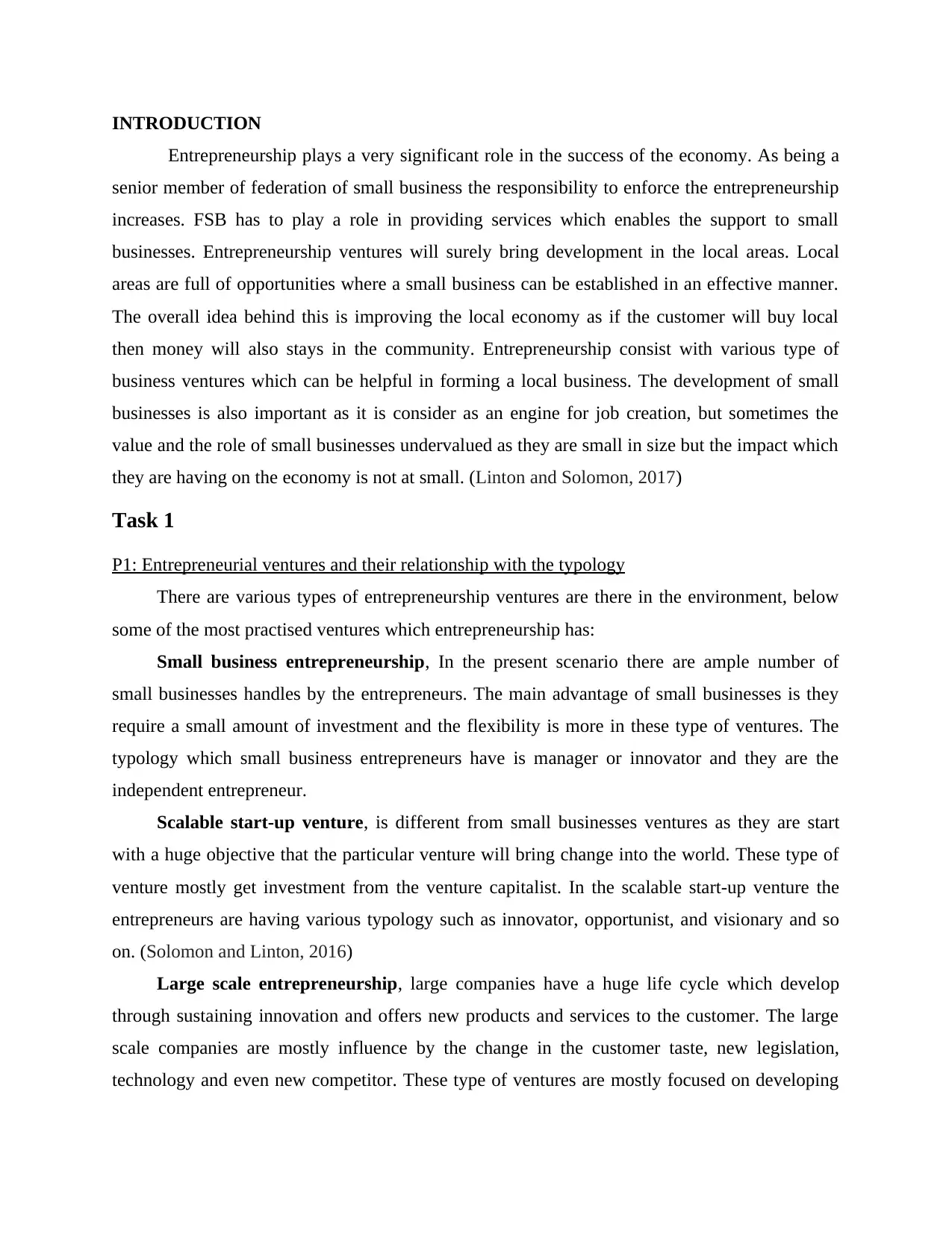
INTRODUCTION
Entrepreneurship plays a very significant role in the success of the economy. As being a
senior member of federation of small business the responsibility to enforce the entrepreneurship
increases. FSB has to play a role in providing services which enables the support to small
businesses. Entrepreneurship ventures will surely bring development in the local areas. Local
areas are full of opportunities where a small business can be established in an effective manner.
The overall idea behind this is improving the local economy as if the customer will buy local
then money will also stays in the community. Entrepreneurship consist with various type of
business ventures which can be helpful in forming a local business. The development of small
businesses is also important as it is consider as an engine for job creation, but sometimes the
value and the role of small businesses undervalued as they are small in size but the impact which
they are having on the economy is not at small. (Linton and Solomon, 2017)
Task 1
P1: Entrepreneurial ventures and their relationship with the typology
There are various types of entrepreneurship ventures are there in the environment, below
some of the most practised ventures which entrepreneurship has:
Small business entrepreneurship, In the present scenario there are ample number of
small businesses handles by the entrepreneurs. The main advantage of small businesses is they
require a small amount of investment and the flexibility is more in these type of ventures. The
typology which small business entrepreneurs have is manager or innovator and they are the
independent entrepreneur.
Scalable start-up venture, is different from small businesses ventures as they are start
with a huge objective that the particular venture will bring change into the world. These type of
venture mostly get investment from the venture capitalist. In the scalable start-up venture the
entrepreneurs are having various typology such as innovator, opportunist, and visionary and so
on. (Solomon and Linton, 2016)
Large scale entrepreneurship, large companies have a huge life cycle which develop
through sustaining innovation and offers new products and services to the customer. The large
scale companies are mostly influence by the change in the customer taste, new legislation,
technology and even new competitor. These type of ventures are mostly focused on developing
Entrepreneurship plays a very significant role in the success of the economy. As being a
senior member of federation of small business the responsibility to enforce the entrepreneurship
increases. FSB has to play a role in providing services which enables the support to small
businesses. Entrepreneurship ventures will surely bring development in the local areas. Local
areas are full of opportunities where a small business can be established in an effective manner.
The overall idea behind this is improving the local economy as if the customer will buy local
then money will also stays in the community. Entrepreneurship consist with various type of
business ventures which can be helpful in forming a local business. The development of small
businesses is also important as it is consider as an engine for job creation, but sometimes the
value and the role of small businesses undervalued as they are small in size but the impact which
they are having on the economy is not at small. (Linton and Solomon, 2017)
Task 1
P1: Entrepreneurial ventures and their relationship with the typology
There are various types of entrepreneurship ventures are there in the environment, below
some of the most practised ventures which entrepreneurship has:
Small business entrepreneurship, In the present scenario there are ample number of
small businesses handles by the entrepreneurs. The main advantage of small businesses is they
require a small amount of investment and the flexibility is more in these type of ventures. The
typology which small business entrepreneurs have is manager or innovator and they are the
independent entrepreneur.
Scalable start-up venture, is different from small businesses ventures as they are start
with a huge objective that the particular venture will bring change into the world. These type of
venture mostly get investment from the venture capitalist. In the scalable start-up venture the
entrepreneurs are having various typology such as innovator, opportunist, and visionary and so
on. (Solomon and Linton, 2016)
Large scale entrepreneurship, large companies have a huge life cycle which develop
through sustaining innovation and offers new products and services to the customer. The large
scale companies are mostly influence by the change in the customer taste, new legislation,
technology and even new competitor. These type of ventures are mostly focused on developing
Paraphrase This Document
Need a fresh take? Get an instant paraphrase of this document with our AI Paraphraser
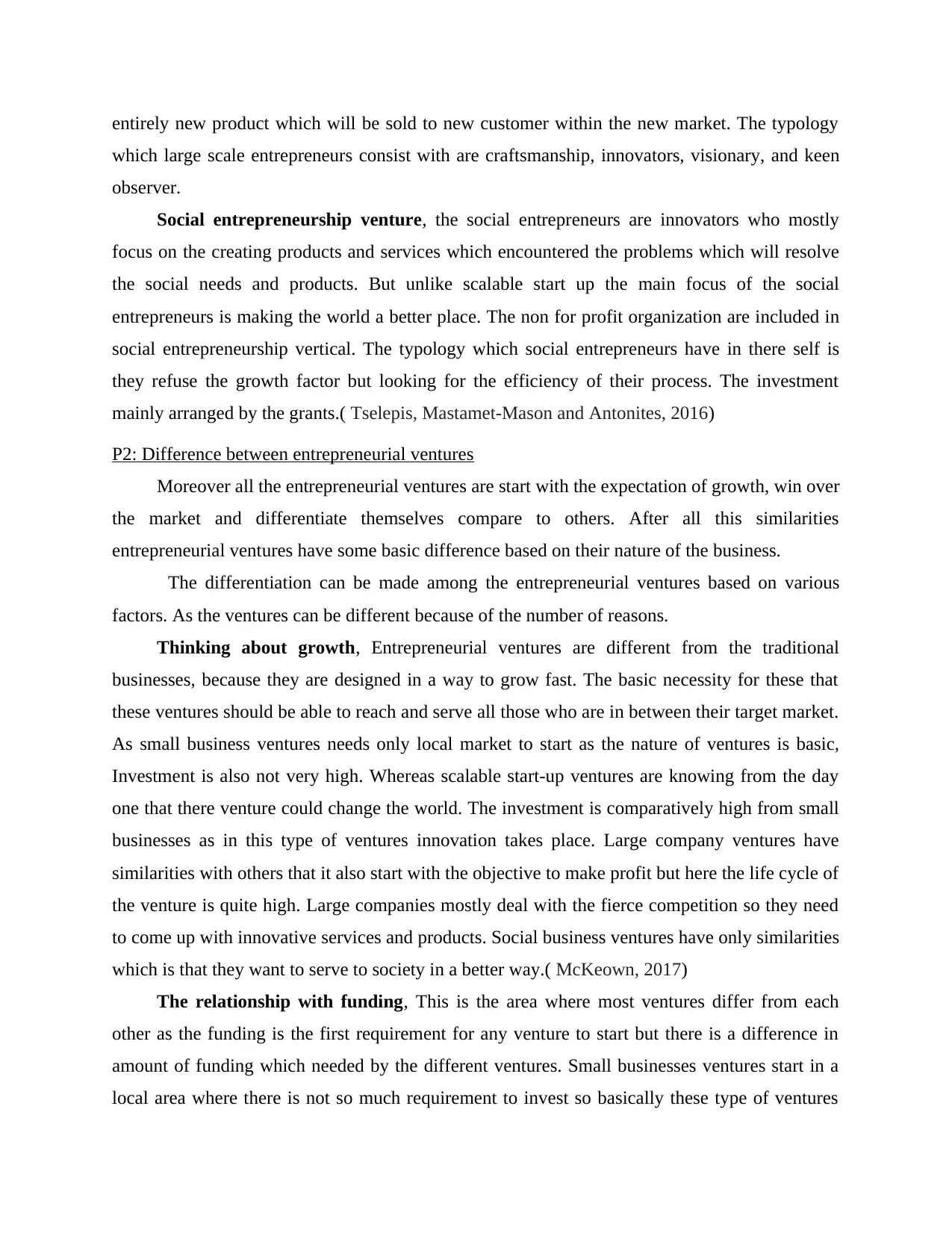
entirely new product which will be sold to new customer within the new market. The typology
which large scale entrepreneurs consist with are craftsmanship, innovators, visionary, and keen
observer.
Social entrepreneurship venture, the social entrepreneurs are innovators who mostly
focus on the creating products and services which encountered the problems which will resolve
the social needs and products. But unlike scalable start up the main focus of the social
entrepreneurs is making the world a better place. The non for profit organization are included in
social entrepreneurship vertical. The typology which social entrepreneurs have in there self is
they refuse the growth factor but looking for the efficiency of their process. The investment
mainly arranged by the grants.( Tselepis, Mastamet-Mason and Antonites, 2016)
P2: Difference between entrepreneurial ventures
Moreover all the entrepreneurial ventures are start with the expectation of growth, win over
the market and differentiate themselves compare to others. After all this similarities
entrepreneurial ventures have some basic difference based on their nature of the business.
The differentiation can be made among the entrepreneurial ventures based on various
factors. As the ventures can be different because of the number of reasons.
Thinking about growth, Entrepreneurial ventures are different from the traditional
businesses, because they are designed in a way to grow fast. The basic necessity for these that
these ventures should be able to reach and serve all those who are in between their target market.
As small business ventures needs only local market to start as the nature of ventures is basic,
Investment is also not very high. Whereas scalable start-up ventures are knowing from the day
one that there venture could change the world. The investment is comparatively high from small
businesses as in this type of ventures innovation takes place. Large company ventures have
similarities with others that it also start with the objective to make profit but here the life cycle of
the venture is quite high. Large companies mostly deal with the fierce competition so they need
to come up with innovative services and products. Social business ventures have only similarities
which is that they want to serve to society in a better way.( McKeown, 2017)
The relationship with funding, This is the area where most ventures differ from each
other as the funding is the first requirement for any venture to start but there is a difference in
amount of funding which needed by the different ventures. Small businesses ventures start in a
local area where there is not so much requirement to invest so basically these type of ventures
which large scale entrepreneurs consist with are craftsmanship, innovators, visionary, and keen
observer.
Social entrepreneurship venture, the social entrepreneurs are innovators who mostly
focus on the creating products and services which encountered the problems which will resolve
the social needs and products. But unlike scalable start up the main focus of the social
entrepreneurs is making the world a better place. The non for profit organization are included in
social entrepreneurship vertical. The typology which social entrepreneurs have in there self is
they refuse the growth factor but looking for the efficiency of their process. The investment
mainly arranged by the grants.( Tselepis, Mastamet-Mason and Antonites, 2016)
P2: Difference between entrepreneurial ventures
Moreover all the entrepreneurial ventures are start with the expectation of growth, win over
the market and differentiate themselves compare to others. After all this similarities
entrepreneurial ventures have some basic difference based on their nature of the business.
The differentiation can be made among the entrepreneurial ventures based on various
factors. As the ventures can be different because of the number of reasons.
Thinking about growth, Entrepreneurial ventures are different from the traditional
businesses, because they are designed in a way to grow fast. The basic necessity for these that
these ventures should be able to reach and serve all those who are in between their target market.
As small business ventures needs only local market to start as the nature of ventures is basic,
Investment is also not very high. Whereas scalable start-up ventures are knowing from the day
one that there venture could change the world. The investment is comparatively high from small
businesses as in this type of ventures innovation takes place. Large company ventures have
similarities with others that it also start with the objective to make profit but here the life cycle of
the venture is quite high. Large companies mostly deal with the fierce competition so they need
to come up with innovative services and products. Social business ventures have only similarities
which is that they want to serve to society in a better way.( McKeown, 2017)
The relationship with funding, This is the area where most ventures differ from each
other as the funding is the first requirement for any venture to start but there is a difference in
amount of funding which needed by the different ventures. Small businesses ventures start in a
local area where there is not so much requirement to invest so basically these type of ventures
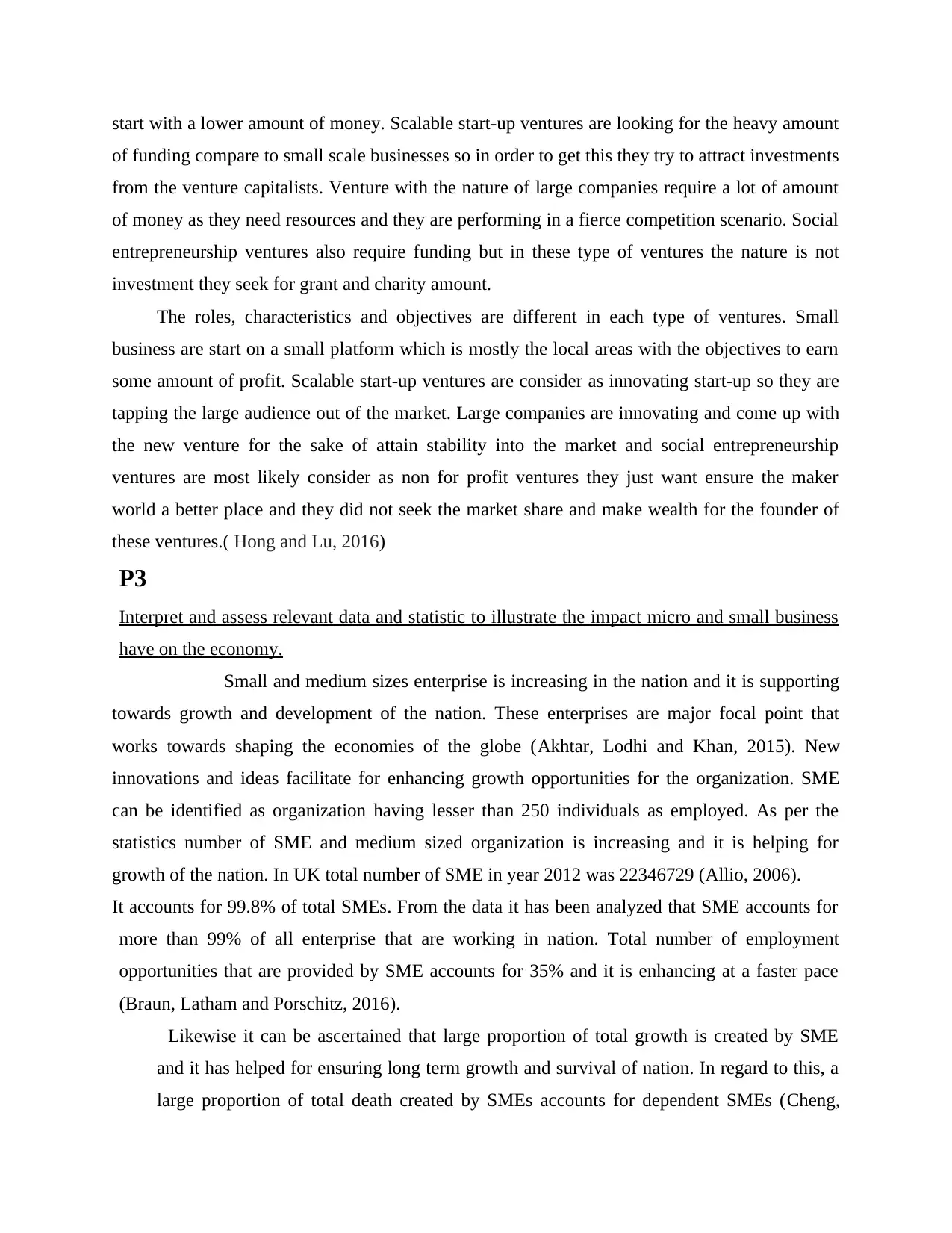
start with a lower amount of money. Scalable start-up ventures are looking for the heavy amount
of funding compare to small scale businesses so in order to get this they try to attract investments
from the venture capitalists. Venture with the nature of large companies require a lot of amount
of money as they need resources and they are performing in a fierce competition scenario. Social
entrepreneurship ventures also require funding but in these type of ventures the nature is not
investment they seek for grant and charity amount.
The roles, characteristics and objectives are different in each type of ventures. Small
business are start on a small platform which is mostly the local areas with the objectives to earn
some amount of profit. Scalable start-up ventures are consider as innovating start-up so they are
tapping the large audience out of the market. Large companies are innovating and come up with
the new venture for the sake of attain stability into the market and social entrepreneurship
ventures are most likely consider as non for profit ventures they just want ensure the maker
world a better place and they did not seek the market share and make wealth for the founder of
these ventures.( Hong and Lu, 2016)
P3
Interpret and assess relevant data and statistic to illustrate the impact micro and small business
have on the economy.
Small and medium sizes enterprise is increasing in the nation and it is supporting
towards growth and development of the nation. These enterprises are major focal point that
works towards shaping the economies of the globe (Akhtar, Lodhi and Khan, 2015). New
innovations and ideas facilitate for enhancing growth opportunities for the organization. SME
can be identified as organization having lesser than 250 individuals as employed. As per the
statistics number of SME and medium sized organization is increasing and it is helping for
growth of the nation. In UK total number of SME in year 2012 was 22346729 (Allio, 2006).
It accounts for 99.8% of total SMEs. From the data it has been analyzed that SME accounts for
more than 99% of all enterprise that are working in nation. Total number of employment
opportunities that are provided by SME accounts for 35% and it is enhancing at a faster pace
(Braun, Latham and Porschitz, 2016).
Likewise it can be ascertained that large proportion of total growth is created by SME
and it has helped for ensuring long term growth and survival of nation. In regard to this, a
large proportion of total death created by SMEs accounts for dependent SMEs (Cheng,
of funding compare to small scale businesses so in order to get this they try to attract investments
from the venture capitalists. Venture with the nature of large companies require a lot of amount
of money as they need resources and they are performing in a fierce competition scenario. Social
entrepreneurship ventures also require funding but in these type of ventures the nature is not
investment they seek for grant and charity amount.
The roles, characteristics and objectives are different in each type of ventures. Small
business are start on a small platform which is mostly the local areas with the objectives to earn
some amount of profit. Scalable start-up ventures are consider as innovating start-up so they are
tapping the large audience out of the market. Large companies are innovating and come up with
the new venture for the sake of attain stability into the market and social entrepreneurship
ventures are most likely consider as non for profit ventures they just want ensure the maker
world a better place and they did not seek the market share and make wealth for the founder of
these ventures.( Hong and Lu, 2016)
P3
Interpret and assess relevant data and statistic to illustrate the impact micro and small business
have on the economy.
Small and medium sizes enterprise is increasing in the nation and it is supporting
towards growth and development of the nation. These enterprises are major focal point that
works towards shaping the economies of the globe (Akhtar, Lodhi and Khan, 2015). New
innovations and ideas facilitate for enhancing growth opportunities for the organization. SME
can be identified as organization having lesser than 250 individuals as employed. As per the
statistics number of SME and medium sized organization is increasing and it is helping for
growth of the nation. In UK total number of SME in year 2012 was 22346729 (Allio, 2006).
It accounts for 99.8% of total SMEs. From the data it has been analyzed that SME accounts for
more than 99% of all enterprise that are working in nation. Total number of employment
opportunities that are provided by SME accounts for 35% and it is enhancing at a faster pace
(Braun, Latham and Porschitz, 2016).
Likewise it can be ascertained that large proportion of total growth is created by SME
and it has helped for ensuring long term growth and survival of nation. In regard to this, a
large proportion of total death created by SMEs accounts for dependent SMEs (Cheng,
⊘ This is a preview!⊘
Do you want full access?
Subscribe today to unlock all pages.

Trusted by 1+ million students worldwide
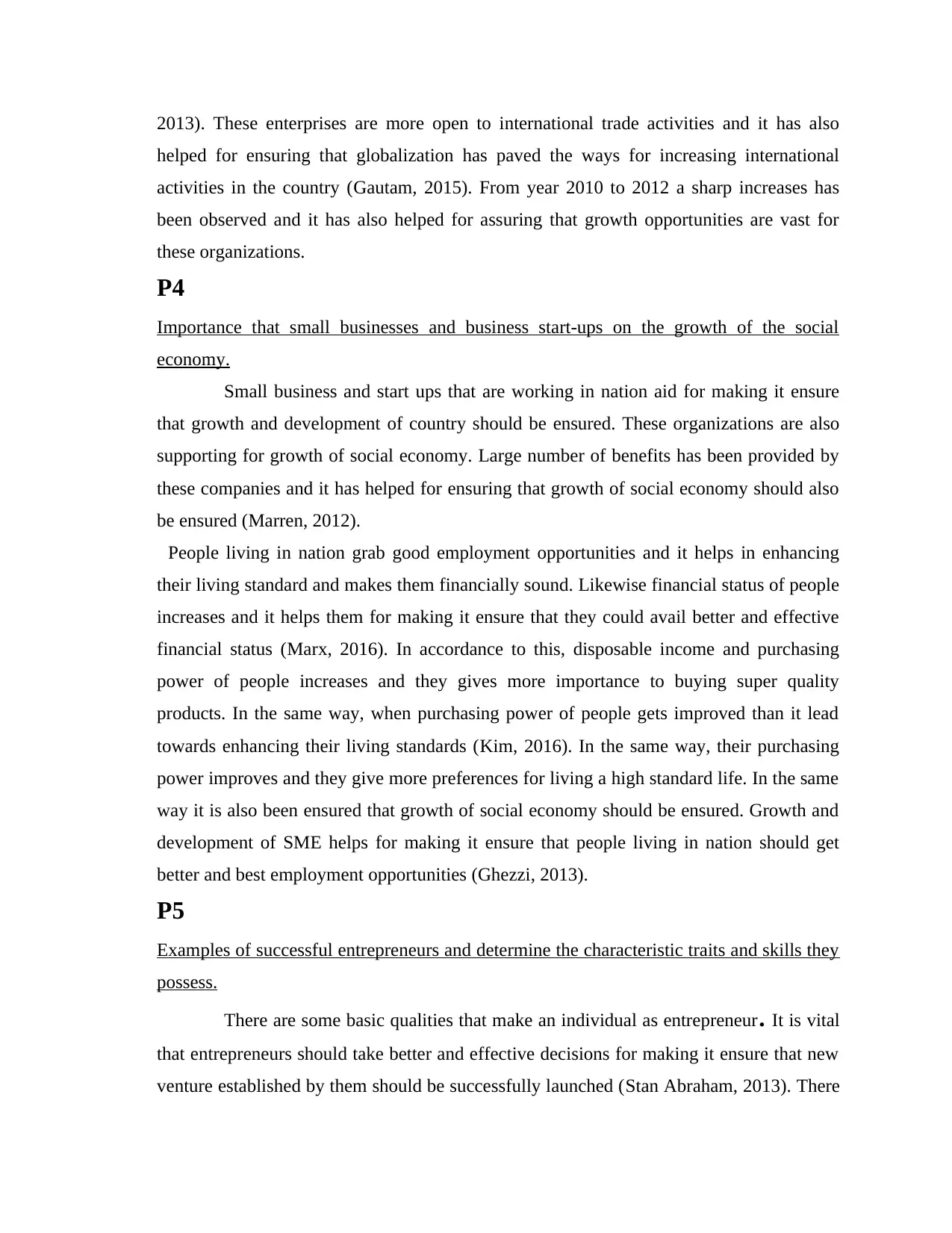
2013). These enterprises are more open to international trade activities and it has also
helped for ensuring that globalization has paved the ways for increasing international
activities in the country (Gautam, 2015). From year 2010 to 2012 a sharp increases has
been observed and it has also helped for assuring that growth opportunities are vast for
these organizations.
P4
Importance that small businesses and business start-ups on the growth of the social
economy.
Small business and start ups that are working in nation aid for making it ensure
that growth and development of country should be ensured. These organizations are also
supporting for growth of social economy. Large number of benefits has been provided by
these companies and it has helped for ensuring that growth of social economy should also
be ensured (Marren, 2012).
People living in nation grab good employment opportunities and it helps in enhancing
their living standard and makes them financially sound. Likewise financial status of people
increases and it helps them for making it ensure that they could avail better and effective
financial status (Marx, 2016). In accordance to this, disposable income and purchasing
power of people increases and they gives more importance to buying super quality
products. In the same way, when purchasing power of people gets improved than it lead
towards enhancing their living standards (Kim, 2016). In the same way, their purchasing
power improves and they give more preferences for living a high standard life. In the same
way it is also been ensured that growth of social economy should be ensured. Growth and
development of SME helps for making it ensure that people living in nation should get
better and best employment opportunities (Ghezzi, 2013).
P5
Examples of successful entrepreneurs and determine the characteristic traits and skills they
possess.
There are some basic qualities that make an individual as entrepreneur. It is vital
that entrepreneurs should take better and effective decisions for making it ensure that new
venture established by them should be successfully launched (Stan Abraham, 2013). There
helped for ensuring that globalization has paved the ways for increasing international
activities in the country (Gautam, 2015). From year 2010 to 2012 a sharp increases has
been observed and it has also helped for assuring that growth opportunities are vast for
these organizations.
P4
Importance that small businesses and business start-ups on the growth of the social
economy.
Small business and start ups that are working in nation aid for making it ensure
that growth and development of country should be ensured. These organizations are also
supporting for growth of social economy. Large number of benefits has been provided by
these companies and it has helped for ensuring that growth of social economy should also
be ensured (Marren, 2012).
People living in nation grab good employment opportunities and it helps in enhancing
their living standard and makes them financially sound. Likewise financial status of people
increases and it helps them for making it ensure that they could avail better and effective
financial status (Marx, 2016). In accordance to this, disposable income and purchasing
power of people increases and they gives more importance to buying super quality
products. In the same way, when purchasing power of people gets improved than it lead
towards enhancing their living standards (Kim, 2016). In the same way, their purchasing
power improves and they give more preferences for living a high standard life. In the same
way it is also been ensured that growth of social economy should be ensured. Growth and
development of SME helps for making it ensure that people living in nation should get
better and best employment opportunities (Ghezzi, 2013).
P5
Examples of successful entrepreneurs and determine the characteristic traits and skills they
possess.
There are some basic qualities that make an individual as entrepreneur. It is vital
that entrepreneurs should take better and effective decisions for making it ensure that new
venture established by them should be successfully launched (Stan Abraham, 2013). There
Paraphrase This Document
Need a fresh take? Get an instant paraphrase of this document with our AI Paraphraser
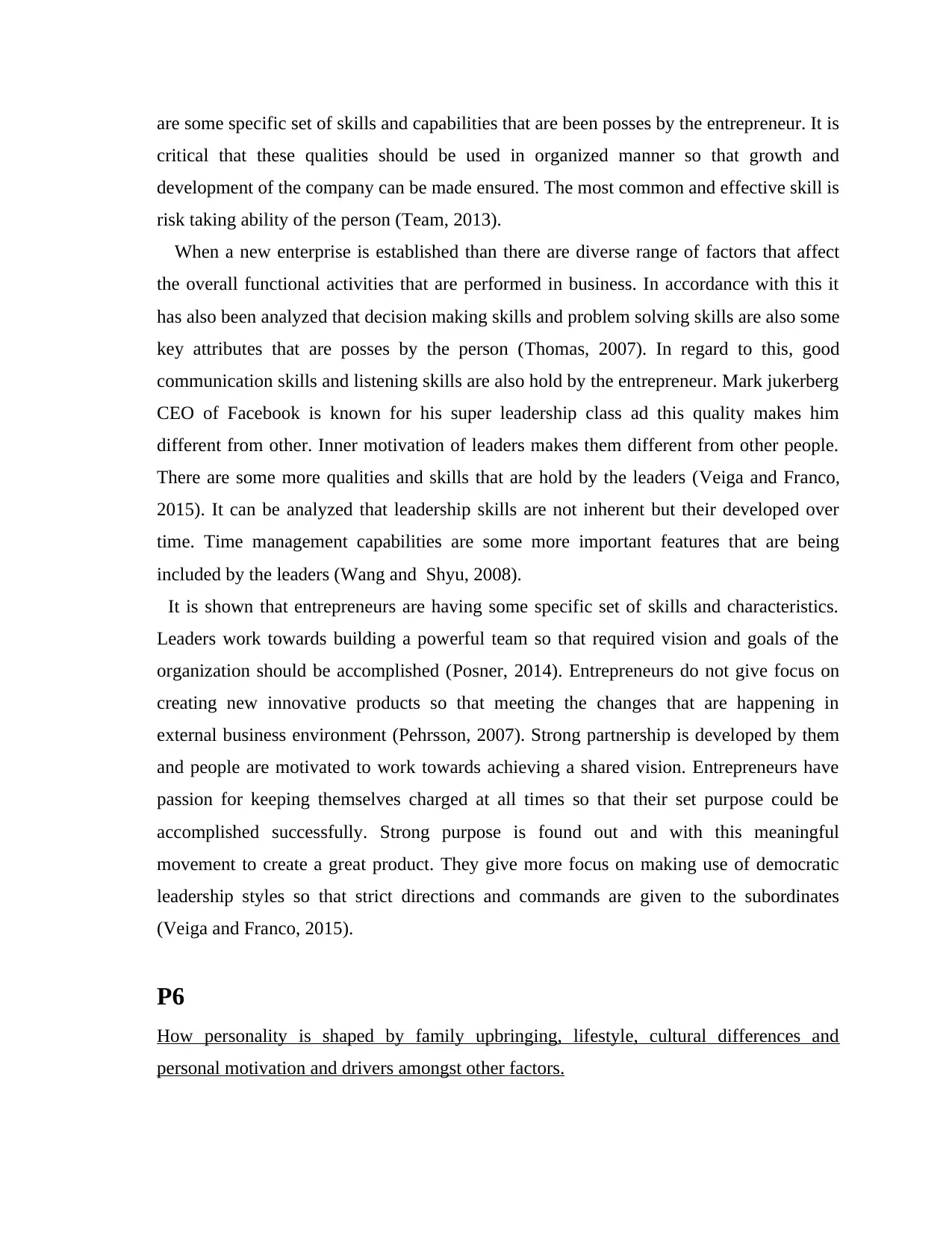
are some specific set of skills and capabilities that are been posses by the entrepreneur. It is
critical that these qualities should be used in organized manner so that growth and
development of the company can be made ensured. The most common and effective skill is
risk taking ability of the person (Team, 2013).
When a new enterprise is established than there are diverse range of factors that affect
the overall functional activities that are performed in business. In accordance with this it
has also been analyzed that decision making skills and problem solving skills are also some
key attributes that are posses by the person (Thomas, 2007). In regard to this, good
communication skills and listening skills are also hold by the entrepreneur. Mark jukerberg
CEO of Facebook is known for his super leadership class ad this quality makes him
different from other. Inner motivation of leaders makes them different from other people.
There are some more qualities and skills that are hold by the leaders (Veiga and Franco,
2015). It can be analyzed that leadership skills are not inherent but their developed over
time. Time management capabilities are some more important features that are being
included by the leaders (Wang and Shyu, 2008).
It is shown that entrepreneurs are having some specific set of skills and characteristics.
Leaders work towards building a powerful team so that required vision and goals of the
organization should be accomplished (Posner, 2014). Entrepreneurs do not give focus on
creating new innovative products so that meeting the changes that are happening in
external business environment (Pehrsson, 2007). Strong partnership is developed by them
and people are motivated to work towards achieving a shared vision. Entrepreneurs have
passion for keeping themselves charged at all times so that their set purpose could be
accomplished successfully. Strong purpose is found out and with this meaningful
movement to create a great product. They give more focus on making use of democratic
leadership styles so that strict directions and commands are given to the subordinates
(Veiga and Franco, 2015).
P6
How personality is shaped by family upbringing, lifestyle, cultural differences and
personal motivation and drivers amongst other factors.
critical that these qualities should be used in organized manner so that growth and
development of the company can be made ensured. The most common and effective skill is
risk taking ability of the person (Team, 2013).
When a new enterprise is established than there are diverse range of factors that affect
the overall functional activities that are performed in business. In accordance with this it
has also been analyzed that decision making skills and problem solving skills are also some
key attributes that are posses by the person (Thomas, 2007). In regard to this, good
communication skills and listening skills are also hold by the entrepreneur. Mark jukerberg
CEO of Facebook is known for his super leadership class ad this quality makes him
different from other. Inner motivation of leaders makes them different from other people.
There are some more qualities and skills that are hold by the leaders (Veiga and Franco,
2015). It can be analyzed that leadership skills are not inherent but their developed over
time. Time management capabilities are some more important features that are being
included by the leaders (Wang and Shyu, 2008).
It is shown that entrepreneurs are having some specific set of skills and characteristics.
Leaders work towards building a powerful team so that required vision and goals of the
organization should be accomplished (Posner, 2014). Entrepreneurs do not give focus on
creating new innovative products so that meeting the changes that are happening in
external business environment (Pehrsson, 2007). Strong partnership is developed by them
and people are motivated to work towards achieving a shared vision. Entrepreneurs have
passion for keeping themselves charged at all times so that their set purpose could be
accomplished successfully. Strong purpose is found out and with this meaningful
movement to create a great product. They give more focus on making use of democratic
leadership styles so that strict directions and commands are given to the subordinates
(Veiga and Franco, 2015).
P6
How personality is shaped by family upbringing, lifestyle, cultural differences and
personal motivation and drivers amongst other factors.
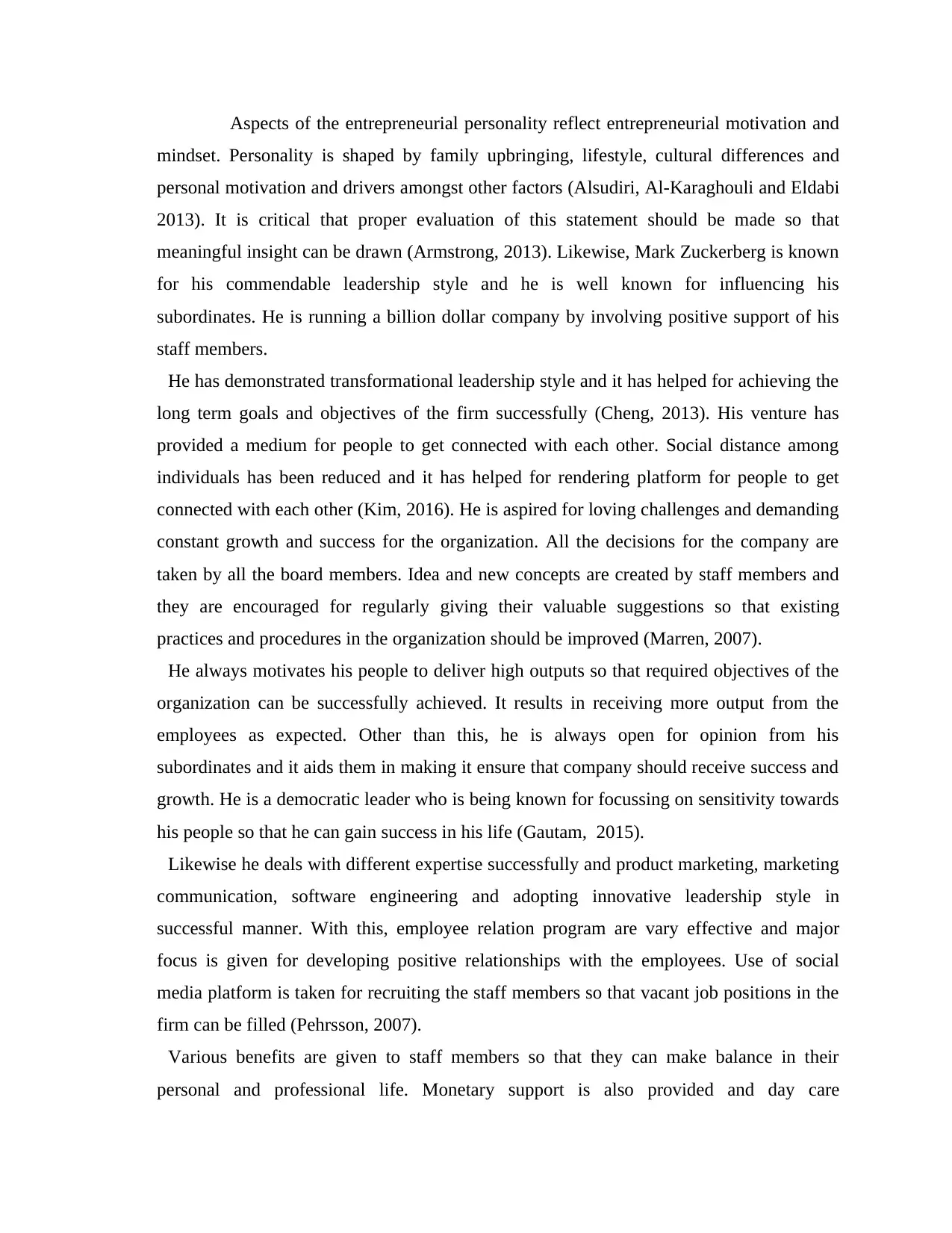
Aspects of the entrepreneurial personality reflect entrepreneurial motivation and
mindset. Personality is shaped by family upbringing, lifestyle, cultural differences and
personal motivation and drivers amongst other factors (Alsudiri, Al-Karaghouli and Eldabi
2013). It is critical that proper evaluation of this statement should be made so that
meaningful insight can be drawn (Armstrong, 2013). Likewise, Mark Zuckerberg is known
for his commendable leadership style and he is well known for influencing his
subordinates. He is running a billion dollar company by involving positive support of his
staff members.
He has demonstrated transformational leadership style and it has helped for achieving the
long term goals and objectives of the firm successfully (Cheng, 2013). His venture has
provided a medium for people to get connected with each other. Social distance among
individuals has been reduced and it has helped for rendering platform for people to get
connected with each other (Kim, 2016). He is aspired for loving challenges and demanding
constant growth and success for the organization. All the decisions for the company are
taken by all the board members. Idea and new concepts are created by staff members and
they are encouraged for regularly giving their valuable suggestions so that existing
practices and procedures in the organization should be improved (Marren, 2007).
He always motivates his people to deliver high outputs so that required objectives of the
organization can be successfully achieved. It results in receiving more output from the
employees as expected. Other than this, he is always open for opinion from his
subordinates and it aids them in making it ensure that company should receive success and
growth. He is a democratic leader who is being known for focussing on sensitivity towards
his people so that he can gain success in his life (Gautam, 2015).
Likewise he deals with different expertise successfully and product marketing, marketing
communication, software engineering and adopting innovative leadership style in
successful manner. With this, employee relation program are vary effective and major
focus is given for developing positive relationships with the employees. Use of social
media platform is taken for recruiting the staff members so that vacant job positions in the
firm can be filled (Pehrsson, 2007).
Various benefits are given to staff members so that they can make balance in their
personal and professional life. Monetary support is also provided and day care
mindset. Personality is shaped by family upbringing, lifestyle, cultural differences and
personal motivation and drivers amongst other factors (Alsudiri, Al-Karaghouli and Eldabi
2013). It is critical that proper evaluation of this statement should be made so that
meaningful insight can be drawn (Armstrong, 2013). Likewise, Mark Zuckerberg is known
for his commendable leadership style and he is well known for influencing his
subordinates. He is running a billion dollar company by involving positive support of his
staff members.
He has demonstrated transformational leadership style and it has helped for achieving the
long term goals and objectives of the firm successfully (Cheng, 2013). His venture has
provided a medium for people to get connected with each other. Social distance among
individuals has been reduced and it has helped for rendering platform for people to get
connected with each other (Kim, 2016). He is aspired for loving challenges and demanding
constant growth and success for the organization. All the decisions for the company are
taken by all the board members. Idea and new concepts are created by staff members and
they are encouraged for regularly giving their valuable suggestions so that existing
practices and procedures in the organization should be improved (Marren, 2007).
He always motivates his people to deliver high outputs so that required objectives of the
organization can be successfully achieved. It results in receiving more output from the
employees as expected. Other than this, he is always open for opinion from his
subordinates and it aids them in making it ensure that company should receive success and
growth. He is a democratic leader who is being known for focussing on sensitivity towards
his people so that he can gain success in his life (Gautam, 2015).
Likewise he deals with different expertise successfully and product marketing, marketing
communication, software engineering and adopting innovative leadership style in
successful manner. With this, employee relation program are vary effective and major
focus is given for developing positive relationships with the employees. Use of social
media platform is taken for recruiting the staff members so that vacant job positions in the
firm can be filled (Pehrsson, 2007).
Various benefits are given to staff members so that they can make balance in their
personal and professional life. Monetary support is also provided and day care
⊘ This is a preview!⊘
Do you want full access?
Subscribe today to unlock all pages.

Trusted by 1+ million students worldwide
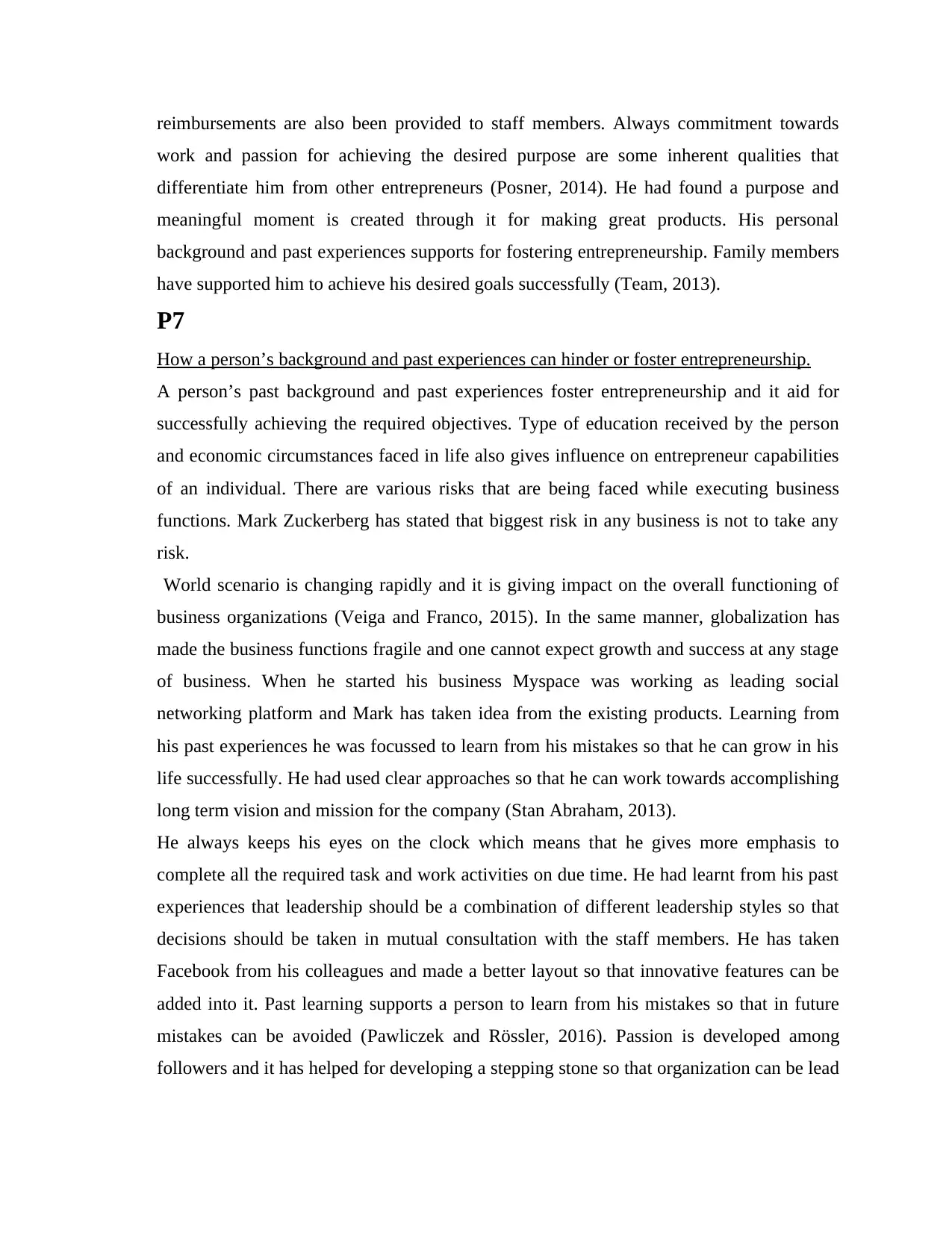
reimbursements are also been provided to staff members. Always commitment towards
work and passion for achieving the desired purpose are some inherent qualities that
differentiate him from other entrepreneurs (Posner, 2014). He had found a purpose and
meaningful moment is created through it for making great products. His personal
background and past experiences supports for fostering entrepreneurship. Family members
have supported him to achieve his desired goals successfully (Team, 2013).
P7
How a person’s background and past experiences can hinder or foster entrepreneurship.
A person’s past background and past experiences foster entrepreneurship and it aid for
successfully achieving the required objectives. Type of education received by the person
and economic circumstances faced in life also gives influence on entrepreneur capabilities
of an individual. There are various risks that are being faced while executing business
functions. Mark Zuckerberg has stated that biggest risk in any business is not to take any
risk.
World scenario is changing rapidly and it is giving impact on the overall functioning of
business organizations (Veiga and Franco, 2015). In the same manner, globalization has
made the business functions fragile and one cannot expect growth and success at any stage
of business. When he started his business Myspace was working as leading social
networking platform and Mark has taken idea from the existing products. Learning from
his past experiences he was focussed to learn from his mistakes so that he can grow in his
life successfully. He had used clear approaches so that he can work towards accomplishing
long term vision and mission for the company (Stan Abraham, 2013).
He always keeps his eyes on the clock which means that he gives more emphasis to
complete all the required task and work activities on due time. He had learnt from his past
experiences that leadership should be a combination of different leadership styles so that
decisions should be taken in mutual consultation with the staff members. He has taken
Facebook from his colleagues and made a better layout so that innovative features can be
added into it. Past learning supports a person to learn from his mistakes so that in future
mistakes can be avoided (Pawliczek and Rössler, 2016). Passion is developed among
followers and it has helped for developing a stepping stone so that organization can be lead
work and passion for achieving the desired purpose are some inherent qualities that
differentiate him from other entrepreneurs (Posner, 2014). He had found a purpose and
meaningful moment is created through it for making great products. His personal
background and past experiences supports for fostering entrepreneurship. Family members
have supported him to achieve his desired goals successfully (Team, 2013).
P7
How a person’s background and past experiences can hinder or foster entrepreneurship.
A person’s past background and past experiences foster entrepreneurship and it aid for
successfully achieving the required objectives. Type of education received by the person
and economic circumstances faced in life also gives influence on entrepreneur capabilities
of an individual. There are various risks that are being faced while executing business
functions. Mark Zuckerberg has stated that biggest risk in any business is not to take any
risk.
World scenario is changing rapidly and it is giving impact on the overall functioning of
business organizations (Veiga and Franco, 2015). In the same manner, globalization has
made the business functions fragile and one cannot expect growth and success at any stage
of business. When he started his business Myspace was working as leading social
networking platform and Mark has taken idea from the existing products. Learning from
his past experiences he was focussed to learn from his mistakes so that he can grow in his
life successfully. He had used clear approaches so that he can work towards accomplishing
long term vision and mission for the company (Stan Abraham, 2013).
He always keeps his eyes on the clock which means that he gives more emphasis to
complete all the required task and work activities on due time. He had learnt from his past
experiences that leadership should be a combination of different leadership styles so that
decisions should be taken in mutual consultation with the staff members. He has taken
Facebook from his colleagues and made a better layout so that innovative features can be
added into it. Past learning supports a person to learn from his mistakes so that in future
mistakes can be avoided (Pawliczek and Rössler, 2016). Passion is developed among
followers and it has helped for developing a stepping stone so that organization can be lead
Paraphrase This Document
Need a fresh take? Get an instant paraphrase of this document with our AI Paraphraser
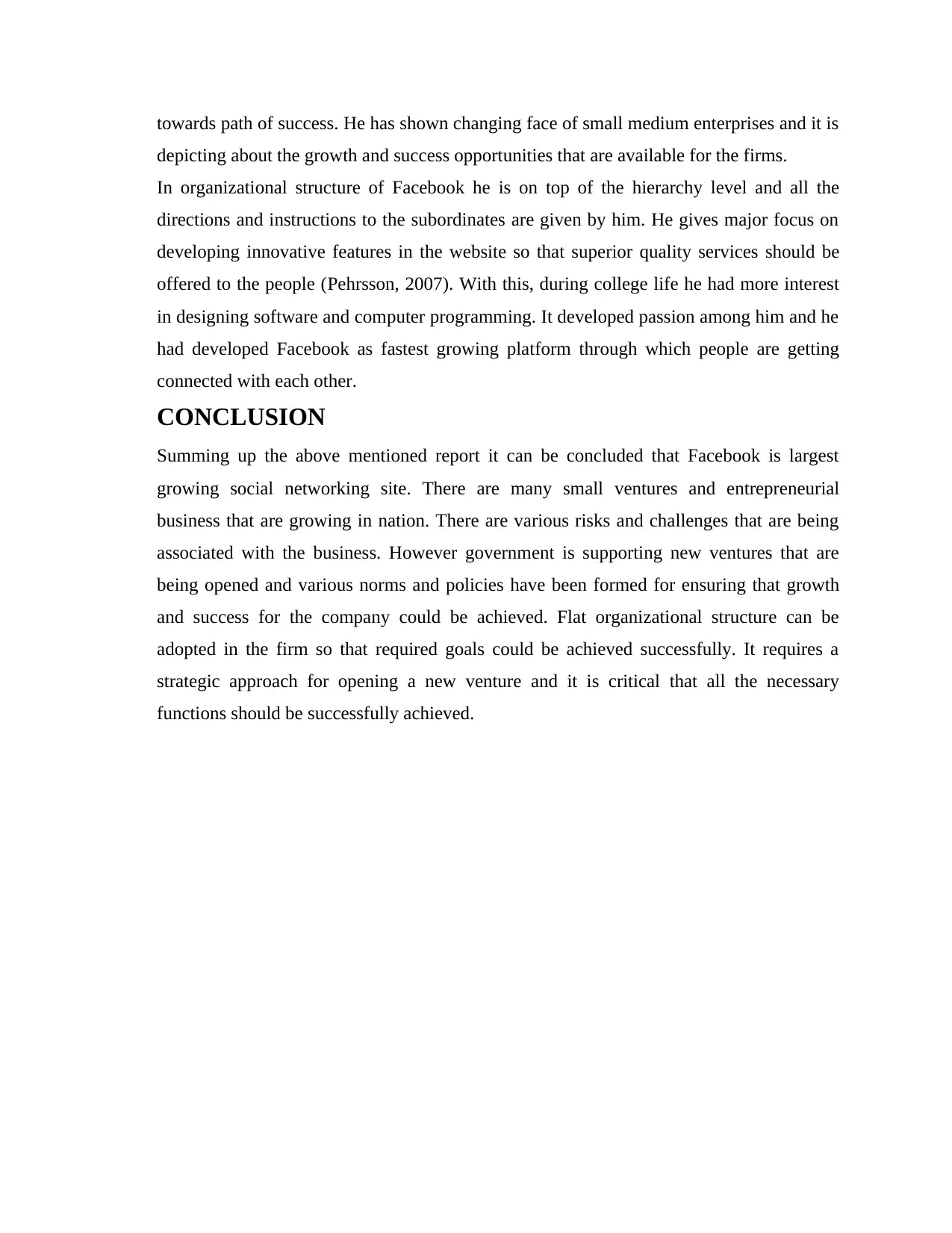
towards path of success. He has shown changing face of small medium enterprises and it is
depicting about the growth and success opportunities that are available for the firms.
In organizational structure of Facebook he is on top of the hierarchy level and all the
directions and instructions to the subordinates are given by him. He gives major focus on
developing innovative features in the website so that superior quality services should be
offered to the people (Pehrsson, 2007). With this, during college life he had more interest
in designing software and computer programming. It developed passion among him and he
had developed Facebook as fastest growing platform through which people are getting
connected with each other.
CONCLUSION
Summing up the above mentioned report it can be concluded that Facebook is largest
growing social networking site. There are many small ventures and entrepreneurial
business that are growing in nation. There are various risks and challenges that are being
associated with the business. However government is supporting new ventures that are
being opened and various norms and policies have been formed for ensuring that growth
and success for the company could be achieved. Flat organizational structure can be
adopted in the firm so that required goals could be achieved successfully. It requires a
strategic approach for opening a new venture and it is critical that all the necessary
functions should be successfully achieved.
depicting about the growth and success opportunities that are available for the firms.
In organizational structure of Facebook he is on top of the hierarchy level and all the
directions and instructions to the subordinates are given by him. He gives major focus on
developing innovative features in the website so that superior quality services should be
offered to the people (Pehrsson, 2007). With this, during college life he had more interest
in designing software and computer programming. It developed passion among him and he
had developed Facebook as fastest growing platform through which people are getting
connected with each other.
CONCLUSION
Summing up the above mentioned report it can be concluded that Facebook is largest
growing social networking site. There are many small ventures and entrepreneurial
business that are growing in nation. There are various risks and challenges that are being
associated with the business. However government is supporting new ventures that are
being opened and various norms and policies have been formed for ensuring that growth
and success for the company could be achieved. Flat organizational structure can be
adopted in the firm so that required goals could be achieved successfully. It requires a
strategic approach for opening a new venture and it is critical that all the necessary
functions should be successfully achieved.
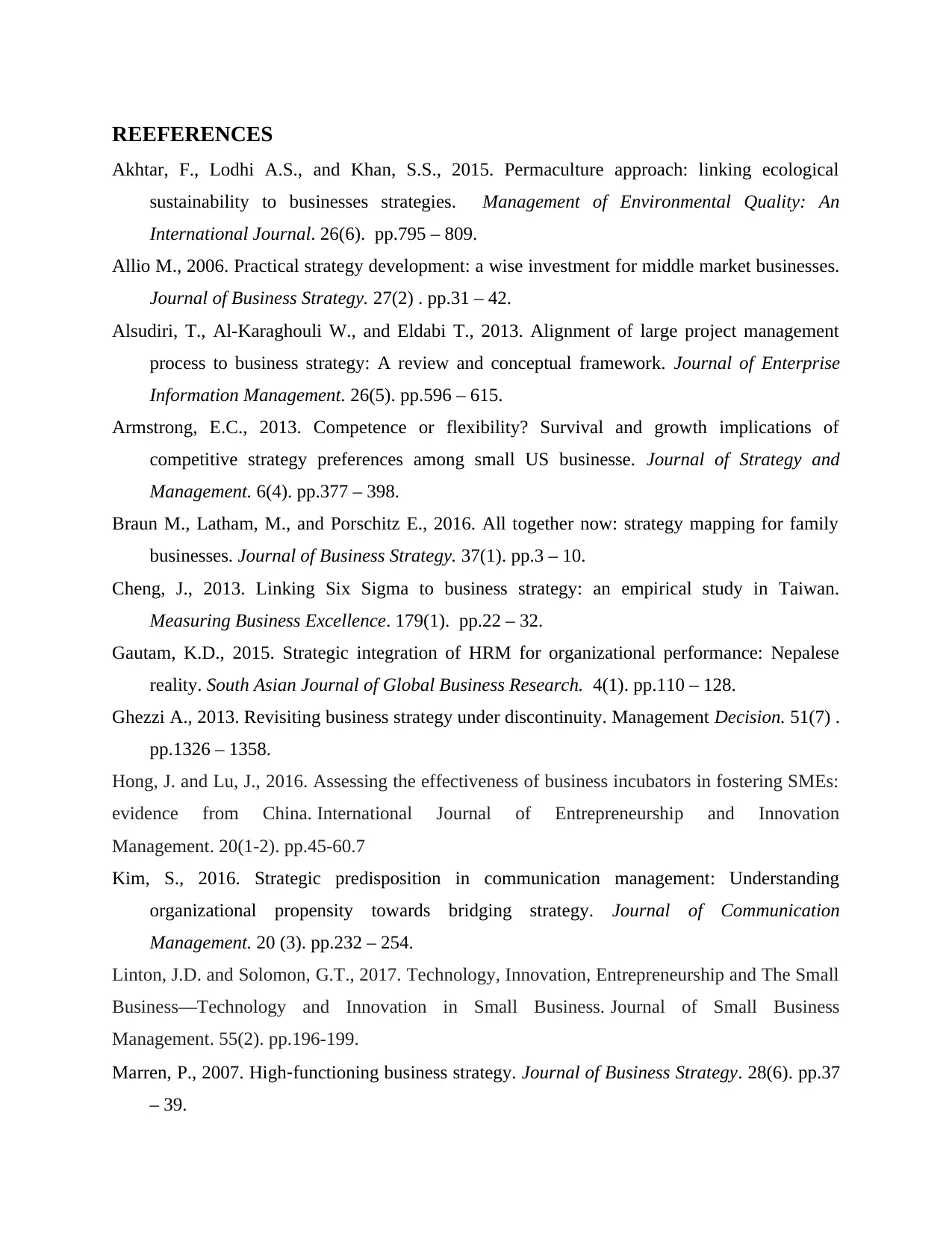
REEFERENCES
Akhtar, F., Lodhi A.S., and Khan, S.S., 2015. Permaculture approach: linking ecological
sustainability to businesses strategies. Management of Environmental Quality: An
International Journal. 26(6). pp.795 – 809.
Allio M., 2006. Practical strategy development: a wise investment for middle market businesses.
Journal of Business Strategy. 27(2) . pp.31 – 42.
Alsudiri, T., Al-Karaghouli W., and Eldabi T., 2013. Alignment of large project management
process to business strategy: A review and conceptual framework. Journal of Enterprise
Information Management. 26(5). pp.596 – 615.
Armstrong, E.C., 2013. Competence or flexibility? Survival and growth implications of
competitive strategy preferences among small US businesse. Journal of Strategy and
Management. 6(4). pp.377 – 398.
Braun M., Latham, M., and Porschitz E., 2016. All together now: strategy mapping for family
businesses. Journal of Business Strategy. 37(1). pp.3 – 10.
Cheng, J., 2013. Linking Six Sigma to business strategy: an empirical study in Taiwan.
Measuring Business Excellence. 179(1). pp.22 – 32.
Gautam, K.D., 2015. Strategic integration of HRM for organizational performance: Nepalese
reality. South Asian Journal of Global Business Research. 4(1). pp.110 – 128.
Ghezzi A., 2013. Revisiting business strategy under discontinuity. Management Decision. 51(7) .
pp.1326 – 1358.
Hong, J. and Lu, J., 2016. Assessing the effectiveness of business incubators in fostering SMEs:
evidence from China. International Journal of Entrepreneurship and Innovation
Management. 20(1-2). pp.45-60.7
Kim, S., 2016. Strategic predisposition in communication management: Understanding
organizational propensity towards bridging strategy. Journal of Communication
Management. 20 (3). pp.232 – 254.
Linton, J.D. and Solomon, G.T., 2017. Technology, Innovation, Entrepreneurship and The Small
Business—Technology and Innovation in Small Business. Journal of Small Business
Management. 55(2). pp.196-199.
Marren, P., 2007. High‐functioning business strategy. Journal of Business Strategy. 28(6). pp.37
– 39.
Akhtar, F., Lodhi A.S., and Khan, S.S., 2015. Permaculture approach: linking ecological
sustainability to businesses strategies. Management of Environmental Quality: An
International Journal. 26(6). pp.795 – 809.
Allio M., 2006. Practical strategy development: a wise investment for middle market businesses.
Journal of Business Strategy. 27(2) . pp.31 – 42.
Alsudiri, T., Al-Karaghouli W., and Eldabi T., 2013. Alignment of large project management
process to business strategy: A review and conceptual framework. Journal of Enterprise
Information Management. 26(5). pp.596 – 615.
Armstrong, E.C., 2013. Competence or flexibility? Survival and growth implications of
competitive strategy preferences among small US businesse. Journal of Strategy and
Management. 6(4). pp.377 – 398.
Braun M., Latham, M., and Porschitz E., 2016. All together now: strategy mapping for family
businesses. Journal of Business Strategy. 37(1). pp.3 – 10.
Cheng, J., 2013. Linking Six Sigma to business strategy: an empirical study in Taiwan.
Measuring Business Excellence. 179(1). pp.22 – 32.
Gautam, K.D., 2015. Strategic integration of HRM for organizational performance: Nepalese
reality. South Asian Journal of Global Business Research. 4(1). pp.110 – 128.
Ghezzi A., 2013. Revisiting business strategy under discontinuity. Management Decision. 51(7) .
pp.1326 – 1358.
Hong, J. and Lu, J., 2016. Assessing the effectiveness of business incubators in fostering SMEs:
evidence from China. International Journal of Entrepreneurship and Innovation
Management. 20(1-2). pp.45-60.7
Kim, S., 2016. Strategic predisposition in communication management: Understanding
organizational propensity towards bridging strategy. Journal of Communication
Management. 20 (3). pp.232 – 254.
Linton, J.D. and Solomon, G.T., 2017. Technology, Innovation, Entrepreneurship and The Small
Business—Technology and Innovation in Small Business. Journal of Small Business
Management. 55(2). pp.196-199.
Marren, P., 2007. High‐functioning business strategy. Journal of Business Strategy. 28(6). pp.37
– 39.
⊘ This is a preview!⊘
Do you want full access?
Subscribe today to unlock all pages.

Trusted by 1+ million students worldwide
1 out of 14
Related Documents
Your All-in-One AI-Powered Toolkit for Academic Success.
+13062052269
info@desklib.com
Available 24*7 on WhatsApp / Email
![[object Object]](/_next/static/media/star-bottom.7253800d.svg)
Unlock your academic potential
Copyright © 2020–2025 A2Z Services. All Rights Reserved. Developed and managed by ZUCOL.





